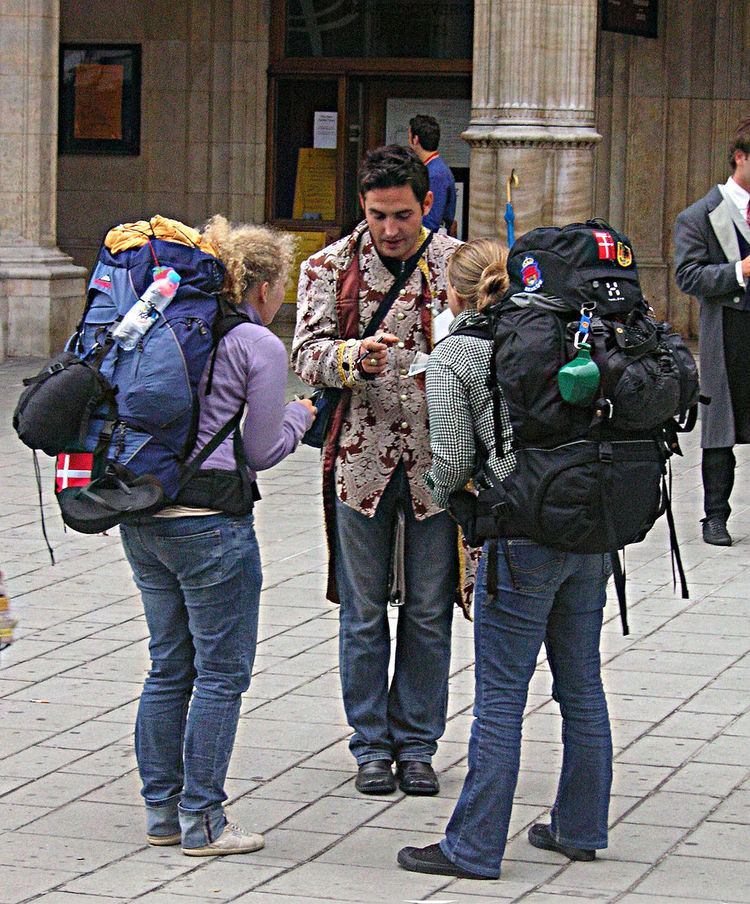 | ||
Backpacking is a form of low-cost, independent travel. It includes the use of a backpack that is easily carried for long distances or long periods of time; the use of public transport; inexpensive lodging such as youth hostels; often a longer duration of the trip when compared with conventional vacations; and often an interest in meeting locals as well as seeing sights.
Contents
Backpacking may include wilderness adventures, local travel and travel to nearby countries while working from the country in which they are based. The definition of a backpacker has evolved as travellers from different cultures and regions participate. A 2007 paper said "backpackers constituted a heterogeneous group with respect to the diversity of rationales and meanings attached to their travel experiences. They also displayed a common commitment to a non-institutionalised form of travel, which was central to their self-identification as backpackers." Backpacking as a lifestyle and as a business has grown considerably in the 2000s as a result of low-cost airlines and hostels or budget accommodations in many parts of the world.
Visa laws in many countries such as Ireland, Australia, Canada, New Zealand and the United Kingdom enable backpackers with restricted visas to work and support themselves while they are in those countries.
History
Seventeenth-century Italian adventurer Giovanni Francesco Gemelli Careri has been suggested as one of the world's first backpackers.
While people have travelled for hundreds of years with their possessions on their backs, the modern concept of backpacking can be traced, at least partially, to the Hippie trail of the 1960s and '70s, which in turn followed sections of the old Silk Road. Some backpackers follow the same trail today.
Over the past few decades, backpackers have descended on South East Asia in huge numbers with popular Thai islands and several previously sleepy towns in Thailand, Cambodia and Laos being transformed by the influx of travellers. Backpacking in Europe, South America, Central America, Australia and New Zealand has also become more popular and there are several well-trodden routes around the world that backpackers tend to stick to.
Technological developments and improvements have contributed to changes in backpacking. Traditionally, backpackers did not travel with expensive electronic equipment like laptop computers, digital cameras and PDAs because of concerns about theft, damage and additional luggage weight. However, the desire to stay connected, coupled with breakthroughs in lightweight electronics, has given rise to a trend that has been termed "flashpacking".
Backpackers have traditionally hauled their possessions in 30 litre to 60 litre backpacks, but roller-wheeled suitcases and some less-traditional carrying methods have become more common, and there has been a trend towards keeping pack weights under the 7kg carry-on limit of most airlines.
Culture
Of importance to some backpackers is a sense of authenticity. Backpacking is perceived as being more than a holiday, but a means of education. Backpackers want to experience the "real" destination rather than the packaged version often associated with mass tourism, which has led to the assertion that backpackers are anti-tourist. For many young people in Northern Europe, Australia, New Zealand and Israel, backpacking is a rite of passage. In Canada, it is quite common for gap-year students to visit Europe. Backpackers are less commonly from China, India, the United States, Japan and South Korea, particularly when taking into account their large populations, accounted for by visa restrictions. But it is also gradually becoming more popular among affluent people from those countries. Backpacking trips were traditionally undertaken either in a "gap year" between high school and university, or between the latter and the commencement of work. However the average age of backpackers has gradually increased over time, and it is common for people in their 30s, 40s and older to backpack during an extended career break. Some retirees enjoy backpacking.
Criticism
Backpacking has been criticised, with some criticism dating back to travellers' behaviour along the Hippie Trail. For example, the host countries and other travellers may disagree with the actions of backpackers. However, the perception of backpackers seems to have improved as backpacking has become more mainstream. Another criticism is that even though one of the primary aims of backpacking is to seek the "authentic," the majority of backpackers spend most of their time interacting with other backpackers, and interactions with locals are of "secondary importance."
Planning and research
Planning and research can be an important part of backpacking, aided by such guides from companies like Lonely Planet and Rough Guides, books by travel authors such as Rick Steves, and various digital and online resources such as Wikivoyage. Resources provide information about such topics as the language, culture, food and history, provide listings of accommodation and places to eat, together with maps of key locations. Digital format guidebooks are becoming more popular, especially since the advent of smart phones and lightweight netbooks and laptops.
Variants
Terms used to describe backpacking with more money and resources include flashpacking, a combination of flash, as in fancy, with backpacking, and poshpacking, a combination of posh, an informal adjective for upper class, and backpacking.
